Your potting soil choice can make or break your potted herb garden. If the soil is too dense, it will be hard for the roots to breathe and extract nutrients from the soil. If it is too porous, it will dry out too fast and your herbs will wither up.
Even if you’re an experienced gardener, finding the best potting soil for herbs in pots can be challenging. There are so many different options that it’s easy to get confused about which one is best!
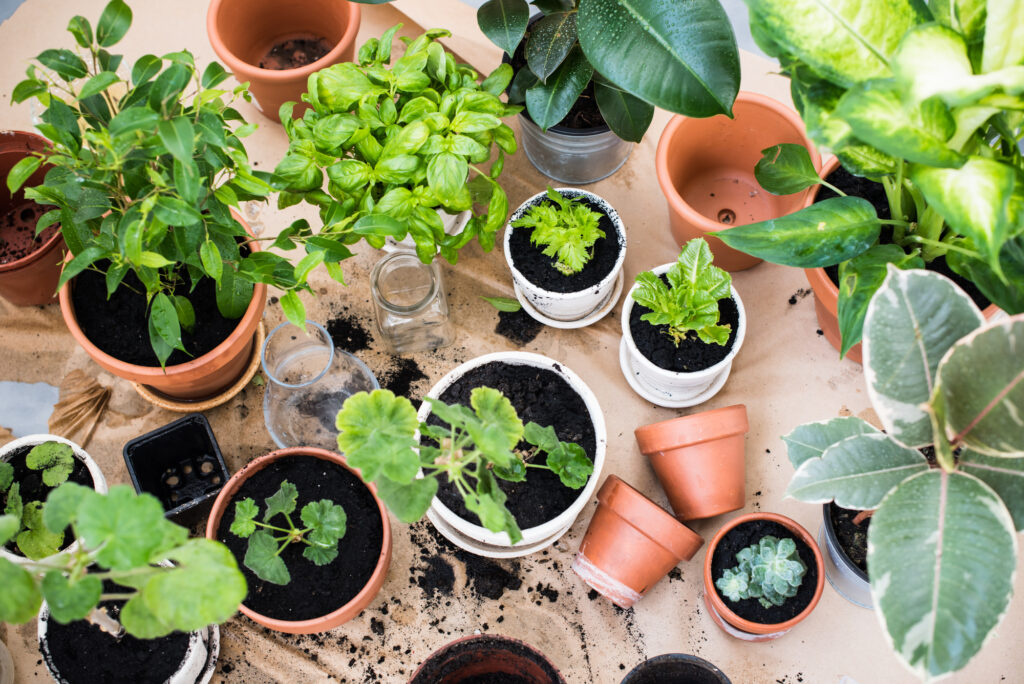
Our Top Potting Soil Choices for Herbs in Pots
We’ve done all of the research for you. Here are our top picks and what makes each one special. This way, anyone who wants to grow their own herbs at home but doesn’t have time to do all of this research on their own can easily find what they need without going through a bunch of trial and error firsthand!
5 Best Potting Soils for Herbs
✔ Miracle-Gro Performance Organics All Purpose Container Mix
✔ Burpee Natural Organic Premium Growing Mix
✔ Espoma Organic Potting Mix
✔ Sun-Gro Black Gold All Organic Potting Soil
✔ Dr. Earth Pot of Gold Premium Organic Potting Soil
I’ve been gardening in containers for decades because I love the flexibility growing in pots offers. I’ve grown to love a really good potting soil that is rich in nutrients, and drains well while also holding moisture. My goal is hassle-free gardening. I don’t have time to baby my plants. You might say I’m a lazy gardener, I like the work to be easy and for the harvest to be bountiful. I think you’ll agree that this selection of potting soils is perfect for your container herb garden, rather you choose to grow them on a window sill or on your patio.
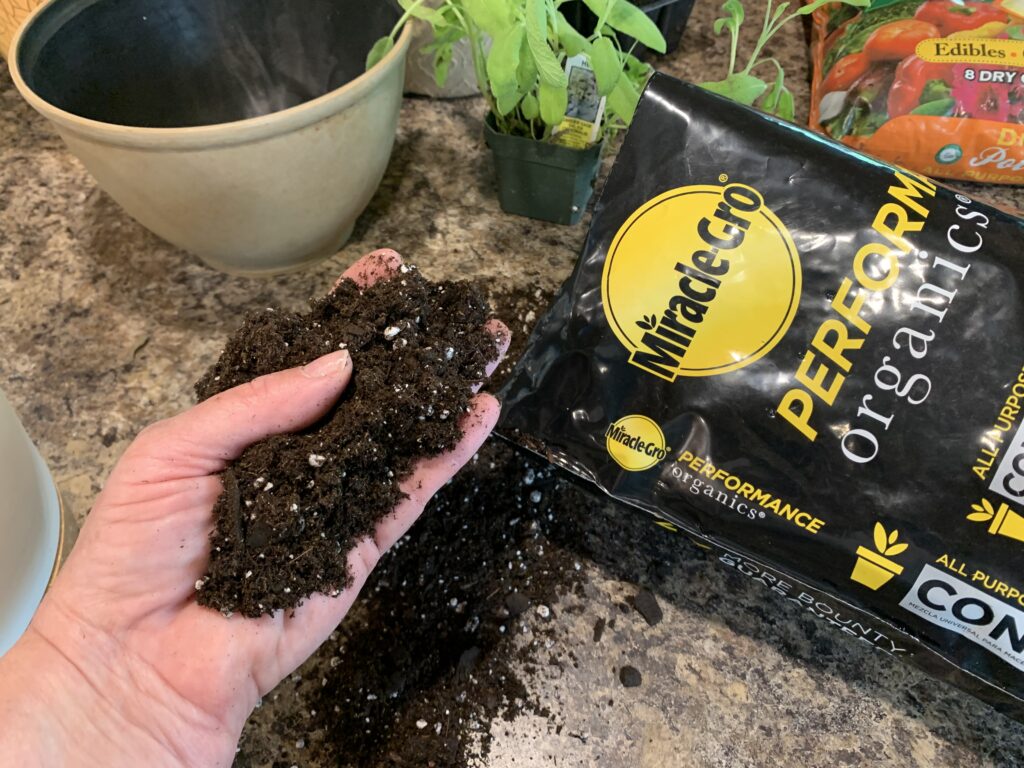
Reviews: Best Potting Soils for Herbs
Miracle-Gro Performance Organics All Purpose Container Mix
KEY FEATURES: Certified for Organics Use (ORMI)
Includes Starter Fertilizer in Mix
Holds moisture well
SIZES AVAIL: 6 qt, 1 cu ft, 1.3 cu ft
CONTENTS: Sphagnum Peat Moss, Processed Forest Products, Perlite, Compost, Organic Fertilizer, and Yucca
FERTILIZER: 39-3-3
ABOUT Miracle-Gro Performance Organics Container Mix
Feed your herbs right from the very beginning! Miracle-Gro Performance Organics Container Mix has the perfect fertilizer ratio for starting your herb garden to continue to feed your plants for up to 3 months. However, 30 days after planting, begin a regular feeding program with Miracle-Gro® Performance Organics® plant food for best results.
Miracle-Gro Performance Organics All-Purpose Container Mix is an organic potting soil that feeds your indoor and outdoor container plants for up to 3 months. It has been tested and proven to deliver twice the bounty vs. unfed plants. That means more herbs for you! It is an all-purpose formula for indoor and outdoor container gardening blended with aged compost. Enjoy Miracle-Gro results with organic and natural ingredients. Miracle-Gro has taken the extra step to get their Performance Mix OMRI listed for organic use so you can be confident of what you are getting.
PROS and CONS of the Miracle-Gro Performance Organics Container Mix
What we love:
Miracle-Gro products have long been one of my favorites for container gardening. It just plain works every time and is super easy for a beginner. So I was delighted when they expanded to the organic line. What I like about this organic soil is the attention to good drainage in the mix while including a lot of moisture-holding materials. Your herbs will do well in this container mix.
Things to consider:
Because this mix holds moisture well, it could be susceptible to a gnat infestation. That’s not a common problem, but pretty annoying if it does happen. For that reason, make sure this soil is pretty dry between waterings, and for indoor gardening, empty your water tray, so your pot is not standing in water.
Burpee Natural Organic Premium Growing Mix
KEY FEATURES: Organic Coconut Coir, finely shredded
Well balanced 3-month organic fertilizers
Disease Resistant
Good Root Air Circulation
SIZES AVAIL: 9 qt
CONTENTS: Organic Coconut Coir and fertilizers
FERTILIZER: 0.12-0.12-0.12
About Burpee’s Natural Organic Premium Growing Mix
If you’re an herb gardener looking for potting soil that will provide your plants with essential nutrients and continue to feed them for up to 3 months, Burpee’s Natural Organic Premium Growing Mix is a perfect choice.
This mix naturally has a high water holding capacity to keep your plants hydrated, and it’s OMRI certified for organic use. Plus, the all-natural ingredients – including plant food and coconut coir – promote healthy seed and root growth. Last but not least, this Burpee organic mix soil is guaranteed, so you can have peace of mind knowing your herbs are growing in a potting mix that meets all of your gardening needs.
PROS and CONS of Burpee Natural Organic Premium Growing Mix
What we love:
We love that the use of Coconut Coir reduces the environmental impact of this growing mix compared to using sphagnum peat moss. And honestly, coir has a lot going for it as a growing medium. It drains well, it holds moisture, and it’s disease resistant. How could you lose? I also love the fully rounded fertilizer levels, which are exactly what you need to help your herbs grow quickly and healthily.
Things to consider:
Because of the higher nutrient level in the blended fertilizer, I’m hesitant to recommend this growing mix for seed starting as it might burn tender plants. Once your seedlings get several sets of leaves, this would be a tremendous repotting medium as you move them to bigger pots.
Espoma Organic Potting Mix
KEY FEATURES: All Natural and Organic
Enhanced Root Development
Nutrient-Rich
SIZES AVAIL: 8 qt, 16 qt, 1 cu ft, 2 cu ft
CONTENTS: Sphagnum peat moss, humus & perlite. Fortified with earthworm castings, alfalfa meal, kelp meal & feather meal. Plus Myco-tone®
FERTILIZER: n/a
About Espoma Organic Potting Mix
Espoma Organic Potting Mix is an excellent mix for potted herbs because it contains humus which improves drainage while retaining moisture; perlite, which provides aeration for roots; and feather meal which supplies essential nitrogen for healthy growth. It also has Myco-tone® added – an endo & ectomycorrhizae blend with proven benefits like increased water uptake, reduced transplant shock, improved fertility utilization, and more. Not only will Espoma Organic Potting Mix help your herbs grow better, but it also contains no artificial ingredients or pesticides, so you know you’re using a safe product.
PROS and CONS of Espoma Organic Potting Mix
What we love:
I love a humusy rich potting material, like Espoma Organic Potting Mix, that allows your plant to pull nutrients right from the soil the way nature intended. Does that mean you’ll get bigger plants? Not necessarily. But if you do happen to be inconsistent with additional fertilizers (like me!), you’ll know your herbs are getting some nutrients from the soil.
Adding mycorrhizae to the soil mix means they have added healthy fungus that naturally occurs in soils. These fungi help transport nutrients to roots.
Things to consider:
There is no starter fertilizer included in the mix, which means you need to start fertilizing on day one. This mix is a little too coarse for starting seeds; try the Espoma Seed Starter instead if that is your goal.
Sun-Gro Black Gold All Organic Potting Soil
KEY FEATURES: Organic, OMRI listed
Rich Loamy Mix
Contains Starter Fertilizer
SIZES AVAIL: 8qt, 16qt, 1 cu ft, 2 cu ft
CONTENTS: Canadian Sphagnum Peat Moss, Composted or Aged Bark, Compost, Earthworm Castings, RESiLIENCE, Horticultural Grade Perlite, Pumice, or Cinders, Organic Grade Fertilizer
FERTILIZER: .05-0-0
About Sun-Gro Black Gold Organic Potting Soil
Sun-Gro Black Gold All Organic Potting Soil has all the features that every high-quality organic potting soil needs: convenience, quality tested organic ingredients and a proven track record of performance. This product is listed by the Organic Materials Review Institute (OMRI) for producing organic food and fiber. The rich loamy mix ensures optimum pore space for sturdy growth, which means no more struggling with wilted or drooping plants because they don’t have enough air circulating. It also contains Canadian Sphagnum Peat Moss, Composted or Aged Bark, Compost, Earthworm Castings, RESiLIENCE, Horticultural Grade Perlite, Pumice or Cinders. Plus, it includes a starter level of Organic Grade Fertilizer.
PROS and CONS of Sun-Gro Black Gold All Organic Potting Soil
What we love:
A loamy soil mix means this feels more like real dirt. However, we love that Black Gold has amended its mix to achieve an outstanding balance between drainage and moisture retention. The low level of starter fertilizer makes this potting soil perfect for starting herb seeds in your window.
Things to consider:
One of the downsides of loamy moisture-retaining soil is if left unable to breathe, it might attract fungus gnats. This mix is a great example when left in storage unopened too long. I’d suggest you open the bag outside when you receive it for a quick inspection. The number of gnat cases reported in reviews is small but enough that I’d double-check before bringing the bag into the house.
Dr. Earth Pot of Gold Premium Organic Potting Soil
KEY FEATURES: Organic, OMRI listed
Composted Green Waste
Eco and Endo Mycorrhizae
SIZES AVAIL: 8qt, 1.5 cu ft
CONTENTS: Aged fir bark, perlite, sphagnum peat moss, composted green waste, sawdust, alfalfa meal, fishbone meal, bone meal, feather meal, kelp meal, eco and endo mycorrhizae, beneficial soil microbes, dolomite lime (ph adjuster) and wetting agent
FERTILIZER: n/a
About Dr. Earth Pot of Gold Premium Organic Potting Soil
Dr. Earth Pot of Gold Premium Organic Potting Soil is an excellent match for your herbs. It’s an abundant blend of natural materials such as bone, fish, feather and alfalfa meals that continue to feed plants over a long period of time. Because it contains TruBiotic® beneficial soil microbes plus mycorrhizal, organic nutrients thoroughly break down before they are released in the soil for plant roots to absorb.
The potting soil includes Pro-Moisture Hydrate to ensure you have adequate moisture for healthy growth. And you won’t have to worry about smells or manure when you use Dr. Earth Pot of Gold Premium Organic Potting Soil.
PROS and CONS of Dr. Earth Pot of Gold Premium Organic Potting Soil
What we love:
We love that this soil is rich in natural materials that continue to feed your herbs over time. And Dr. Earth has added mycorrhizal and soil microbes to aid your plants in absorbing the available nutrients.
Things to consider:
This blend will hold moisture well, so for herbs that like drier soils, you should add something for better air movement like perlite.
Why is it essential to have good potting soil for herbs?
Growing herbs in pots is different from growing herbs in your garden or on raised beds. When you choose the best potting soil for herbs, you can be confident that your plants will get the soil they need for good health, proper watering and excellent drainage. These are important characteristics of potting soil. You can ensure that your herbs exactly receive what they want to thrive.
What’s the difference between potting soil and garden soil?
Potting soil creates the right conditions to provide the best growing environment for plants in containers. Calling potting soil “soil” is a little deceiving because, in reality, potting soil is a mix of different ingredients like dirt, vermiculite, perlite, peat moss, bark and other organic materials. You might be surprised to learn that many potting soils have no dirt in them at all.
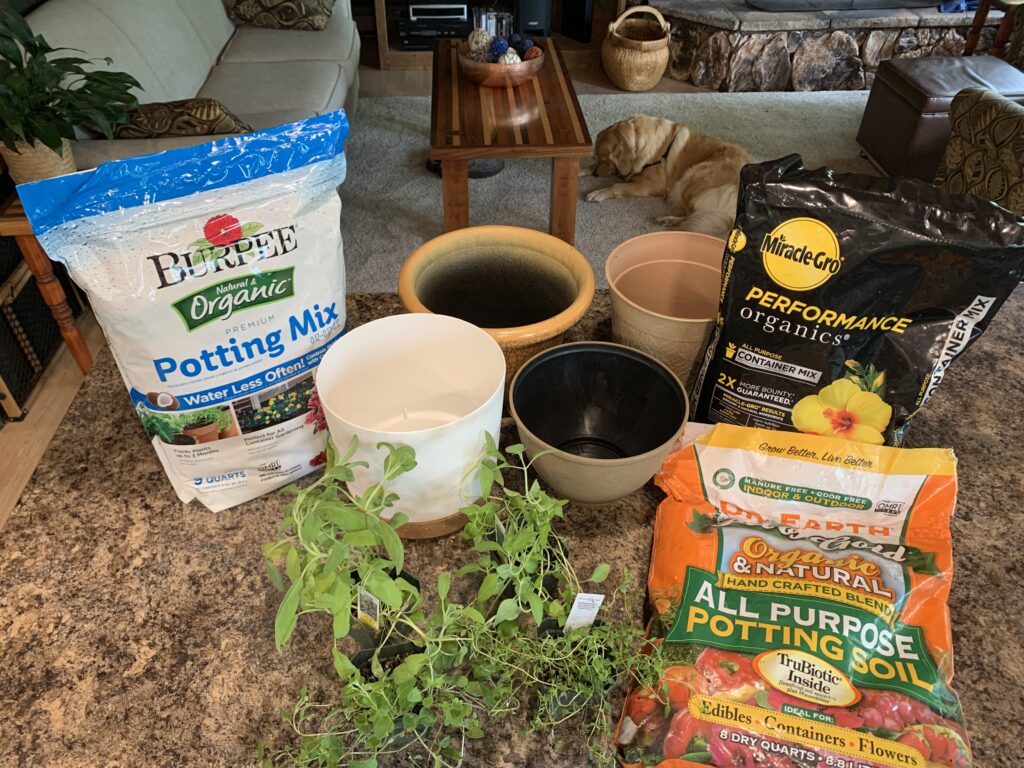
Things to look for in a good potting soil mix
A few ingredients create the best potting soil mix for herbs. When you are looking for potting soil, you should be on the lookout for:
Use Organic Potting Soil for Herbs
For food you’re going to eat, organic potting soil makes a lot of sense. Why take the risk that substances in your potting soil are absorbed into your herbs and then absorbed into your body? Herbs present a more considerable risk because we often dry them and use them in a refined form, such as in oils or powders, so your exposure to chemicals found in the leaves is multiplied.
The cost of organic soils is equivalent to other mixes, and they are readily available. So without getting into a full-scale discussion about why organic is better for food sources, I see this as an easy choice of “why not” use the best organic potting soils. Why take a risk if you don’t have to?
H4 What is ORMI listed?
You’ll see a lot of organic potting mixes with ORMI listed on the label. That means the potting mixes were reviewed by the independent agency Organic Materials Review Institute to be safe for use in organic crop production. This is voluntary and not required for potting soils to be labeled as organic.
Drainage
The soil in the best potting soil for herbs must drain quickly. Waterlogged soil will cause your herbs to wilt and die. When someone shows me a sick plant, the majority of the time, it is a result of soggy roots. If the soil is too wet, the roots are smothered and can’t absorb oxygen from the air. The cells in plant roots need oxygen to live, so if left in soggy soil too long, the cells in the roots die. And then, without those roots, the rest of the plant dies.
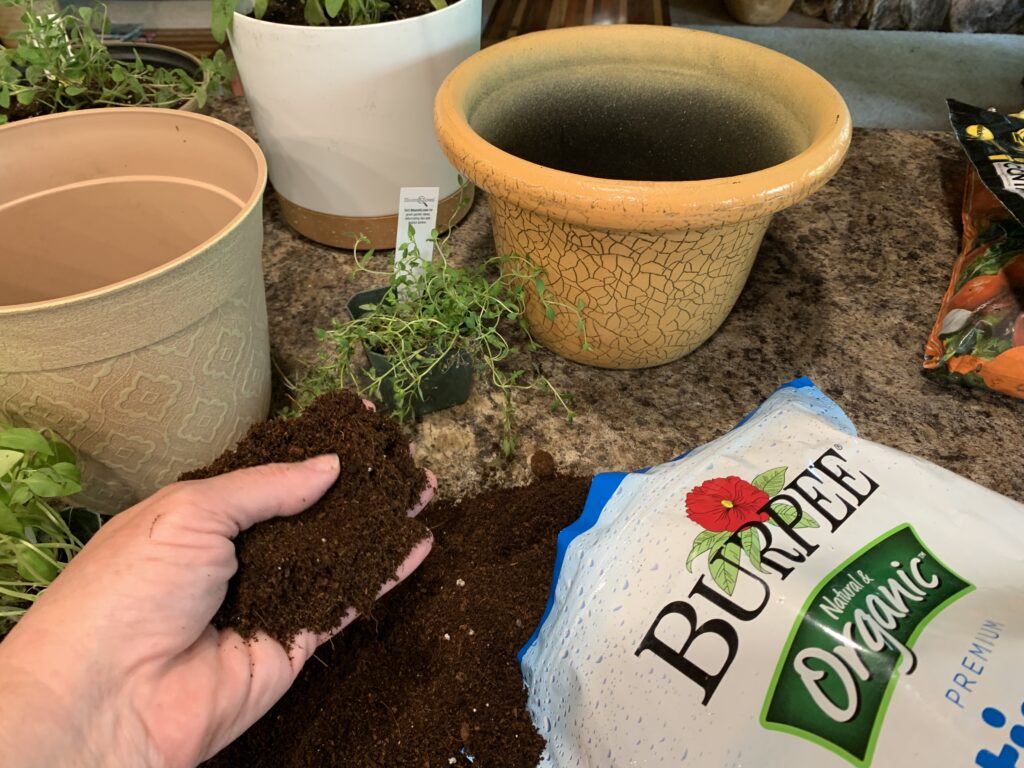
Moisture Retention
It seems like a contradiction, doesn’t it? But just as important as good drainage, you want potting soil that retains moisture. A good visual example is a sponge. A sponge has many air holes (porous) which allow air to move through it, while at the same time, it can soak up a lot of water. In potting soil, organic matter like peat, bark and vermiculate hold moisture, so it’s readily available to your herbs.
Nutrients
Potting soil nutrients are essential to your herbs. Most premium potting soils will already contain a blend of Nitrogen, Potassium and Phosphorus, plus micronutrients that are needed for your herbs to grow. Potting soils that don’t already possess these nutrients will need regular fertilization.
Soil PH
The great majority of herbs prefer a soil PH that is slightly acidic to neutral. You are in luck because, except for specialty potting soils, the great majority of potting soils already fall into this range.
When using the recommended potting soils, you only need to worry about soil PH when you live in an area with very high alkaline water. You’ll know you have this problem when you notice lime build up on the soil’s surface.
Addition of soil amendments
Quality, professional potting mixes will already have the right blend of amendments to ensure you grow healthy herbs. However, if you are making your potting soil mix, you’ll want to add amendments to ensure you have a good balance of drainage and moisture retention.
Here are the most common amendments you’ll find in potting soil mixes
- Sphagnum Peat Moss: Sphagnum peat moss is one of the most common amendments. It has good water and air holding characteristics, and it acts as a soil conditioner to help improve aeration, and drainage and reduce compaction. In recent years, agriculture has been moving away from using sphagnum peat moss because our usage has exceeded nature’s ability to replace it.
- Coconut Coir: Coconut husks are the source of coir, a byproduct of the coconut industry. It has similar water retention and nutrient content to peat moss. Because it is a wasted byproduct, the trend toward using coir instead of peat moss increases.
- Vermiculite: Another prevalent ingredient in potting soils is vermiculite. This amendment holds water and nutrients well but has low nutrient retention, so use it in concert with a good potting soil mix.
- Perlite: Perlite is commonly utilized in seed-starting and potting soil mixes since it keeps the soil loose, aerated, and draining. It doesn’t hold moisture well, so mix perlite with other organic material for healthy plant growth.
- Aged, Composted Manure: Composted manure is one of the best amendments you can add to your potting soil mix. It is high in nutrients, helps with water retention and increases the soil’s cation exchange capacity.
- Composted wood fiber: Research on these materials show promise as components of a soilless potting medium. It adds nutrients and structure to the potting mix and keeps it out of landfills.
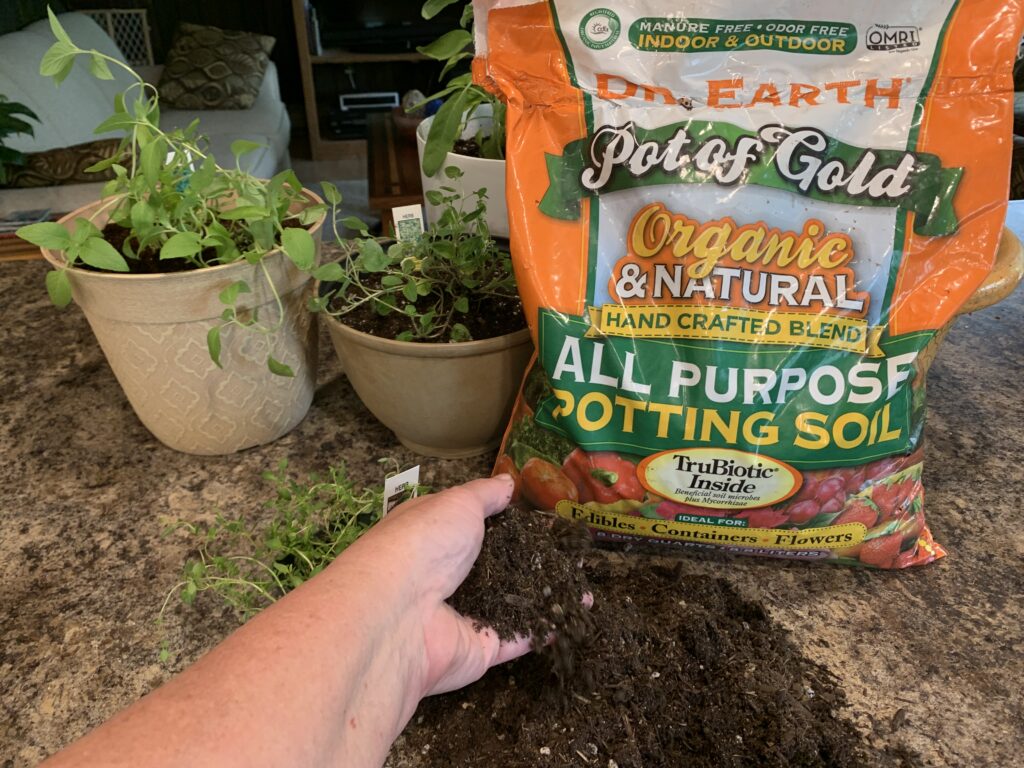
The Role of Soil Microbes (including mycorrhizal) in Potting Soil
Soil microbes occur naturally in your garden. They include fungus, bacteria, and nematodes. Beneficial soil microbes form symbiotic relationships with plants. The roots of your plants make food for the microbes. In turn, those microbes protect the plant from stress and feed it by converting and storing nutrients in the soil.
The microbes help your plant use the natural nutrients found in your potting soil’s organic materials, as well as use applied fertilizers more efficiently. You’ll often see potting soils list eco and endo mycorrhizae as an amendment to their mix.
Can you make your own soil mix for potted herbs?
Absolutely! When I’m filling lots of pots for the patio in the spring, I often start with 50-pound bags of inexpensive potting soil. I dump it into the wheelbarrow and mix in perlite to improve the drainage and peat moss for water retention. I may also add slow-release fertilizer pellets and other organic materials depending on the soil quality.
Indoor Pots vs. Outdoor Pots
It also makes a difference if you grow your herb pots in your kitchen window or on your patio, as the climate conditions vary. When planting in pots outside, the temperatures might vary from 50 degrees to 100 degrees while your kitchen garden luxuriously grows at a constant 72 degrees.
That means for outside pots, you need soil that will retain more moisture in preparation for those scorching days. In contrast, potting soil that dries out a little quicker produces better results.
Which Herbs Grow well in pots
Pretty much any herb can be successfully grown in pots as long as you have the right potting soil mix and provide the proper care. However, some herbs just seem to do better than others in pots.
Herbs with more compact growth tend to be more attractive for a kitchen garden. If you are just starting: chives, parsley, thyme, and basil are a few favorites to grow in pots because they don’t get too big, they have a compact shape, and they are relatively easy to care for. Plus, they are herbs you are likely to use often.
Some kitchen gardeners don’t like the ungainly look of taller herbs like sage, dill and tarragon, although all will grow profusely inside.
How to Plant Herbs in Pots
Which herbs can you cultivate together?
When growing herbs close to each other or even in one big pot, you should group plants that like similar conditions. Plants that like lots of sun and dry conditions would be planted in one pot, while plants that prefer moist soil would go into another pot.
Soil depth requirement for herbs
So you see those cute little herb pots online and think they will look adorable in your kitchen window. Think again! The majority of herbs need 6 to 8 inches of soil depth to thrive. And if you are placing your herb pots outside, you should consider pots at least 10 inches deep so they can retain enough water to get your plants through a hot summer day.
Looking after your container herb garden
Removing abundant growth encourages new branches and leaves to grow. As a general rule, don’t cut your herbs back more than 4-6 inches from the start of the growth.
What are some common problems with herbs?
Herbs don’t like soggy soil, so they may be overwatered if you notice them looking droopy and the leaves turning yellow. Overwatering looks similar to underwatering because when roots are saturated, they can’t pull water into the plant.
Regularly fertilize your plants. If you started with potting soil that included fertilizer, mark your calendar to begin fertilizing when it runs out.
Another common problem is over-fertilizing, which can cause the leaves to turn yellow or even brown.
Herbs also like an abundance of sun, so spindly growth is usually a sign they need more light.
Moving Pots Indoors for the Winter
One of the coolest things about growing your herbs in pots on your patio is that you can move them indoors for fresh herbs year-round. Before you make a move, check your herbs for insects, especially whiteflies, and treat them before you bring them in.
You can move herbs indoors in September or even early October. Just be sure to adjust your plants gradually so they don’t get shocked by the change in conditions. Make sure you bring in your pots before the temperatures drop in the fall. If you wait until it is chilly, your herbs will start to go dormant, and it will be hard to get them going again inside.
And make sure you put them in a spot with abundant sunlight. They’ve been in the bright summer sun for months, so don’t starve them!
FAQs
What type of potting soil is best for herbs?
Any light potting soil that drains well is good for herbs. Be sure to add some organic matter like compost or peat moss to help the soil hold nutrients.
Can I grow mint in a pot?
Yes, but be aware that mint can quickly take over a pot. You may want to plant it in a container separate from other herbs so the mint doesn’t crowd them out.
Should I fertilize my herbs?
Yes, herbs need regular feeding, just like any other plant. Fertilize them every 2-3 weeks using a balanced fertilizer like 10-10-10.
What if I forget to water my herbs?
Herbs can go for a week or two without water, but they will start to look droopy, and the leaves will begin to turn yellow. If you can’t water them for more than a week, consider moving them to a pot with a self-watering system.
Can I use regular potting soil for herbs?
Herbs need potting soil that is light and drains well. Most all-purpose potting soils for houseplants are perfect for herbs. However, if you want to use the heavy, big bags of potting soil that are usually sold in the spring, it’s going to need some help for drainage and nutrients. Be sure to add some organic matter like compost or peat moss to help the soil hold nutrients and perlite for drainage.
What if I don’t have a lot of sun?
Herbs need 6-8 hours of sunlight a day to thrive. If you don’t have a lot of sun, consider using a grow light inside. For outdoor gardens, covet the sunniest spot you can find. That’s what makes using pots for herbs so great outdoors. You can utilize sunny spaces that usually wouldn’t make a good garden location.
I’m going on vacation. What should I do with my herbs?
Inside herbs can occasionally go a week without water. But outside, you are the whim of nature: your herbs are not going to survive in their pots for an extended period in the full sun. Here are a couple of things you can do both inside and outside:
- Move your pots to a shaded spot while you are gone. Your herbs will need less water and can easily survive a week or more of reduced light.
- Use a self-watering system.
- For outdoor pots, add a layer of straw or mulch around the base of the roots and the pots to reduce evaporation.
What happens if I overwater my herbs?
Herbs don’t like soggy soil, so if you notice them looking droopy and the leaves turning yellow, they may be overwatered. Make sure your container has good drainage to allow extra water to escape. Then let the potting soil dry out before you water again.
The Best Potting Soil for Herbs in a Nutshell
Potted plants have different soil needs than garden plants. They require potting soil that supports their herbs and provides proper watering and excellent drainage so they don’t die from overwatering.
For the best results, go with light potting soil that drains well and includes organic matter like compost or peat moss to help it hold nutrients. Commercially available potting soil mixes, as we listed above, are perfect for herbs because the work to mix the soil for maximum growth has been done for you!
If you want to ensure your herbs are healthy and happy, it is essential to take the time to find good potting soil. Choosing the best potting soil for herbs is incredibly easy when you start with one of the organic potting mixes we’ve suggested. Then you can enjoy a kitchen filled with fresh herbs!








